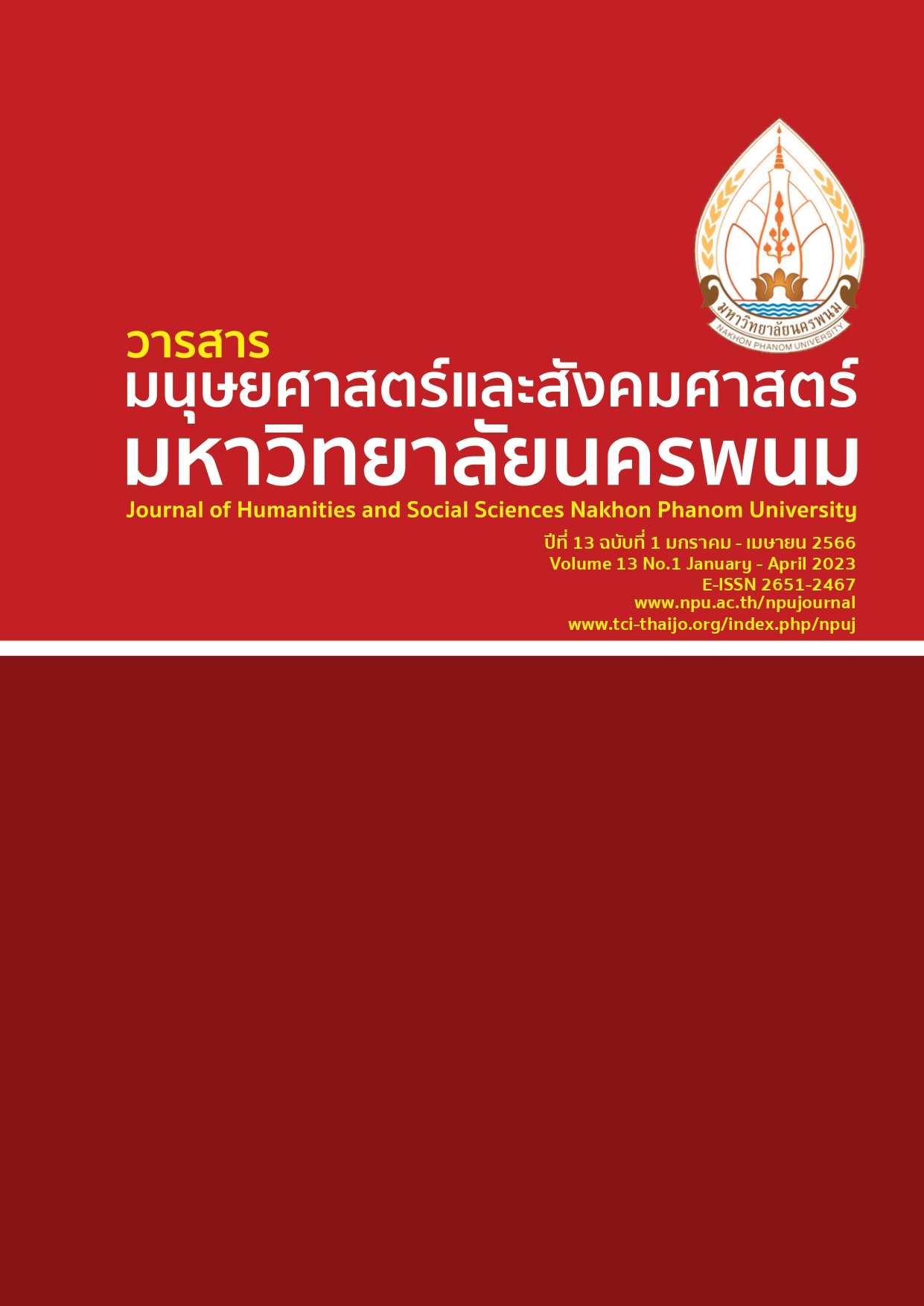Causal Model Affecting Learning and Innovation Skills of Students Demonstration Secondary School, Nakhon Pathom Province
Main Article Content
Abstract
This research aimed to study a causal factors affecting learning and innovation skills of students at demonstration secondary school in Nakhon Pathom. The sample group consisted of 300 grade 12 students from demonstration school in Nakhon Pathom using stratified sampling. The research instrument was a questionnaire. The data analysis used descriptive statistics and covariance-based structural equation modeling (CB-SEM). The research results revealed that 1) the theoretical model was consistent with the empirical data (χ2/df=1.63, TLI=.95, CFI=.96, RMSEA=.06, SRMR=.04); and 2) the achievement motivation significantly affected learning and innovation skills (β=.48), and educational standards also affected learning attitude significantly (β=.66), as well as the learning attitude significantly affected achievement motivation (β=.84). The contributions of the research show that school administrators, teachers, parents, and involved people should organize activities that support students’ achievement motivation and learning attitude, develop the lesson plans and educational standards as well as learning environment contributing to student’s learning and innovation skills.
Article Details

This work is licensed under a Creative Commons Attribution-NonCommercial-NoDerivatives 4.0 International License.
References
Alsalhi, N. R., Eltahir, M. E., and Al-Qatawneh, S. S. (2019). The effect of blended learning on the achievement of ninth grade students in science and their attitudes towards its use. Heliyon, 5(9),1-11. https:// doi.org/10.1016/j.heliyon.2019.e02424
Barak, M., Watted, A., and Haick, H. (2020). Establishing the validity and reliability of a modified tool for assessing innovative thinking of engineering students. Assessment and Evaluation in Higher Education. 45(2),212-223. https://doi.org/10.1080/02602938.2019.1620680
Barak, M. and Yuan, S. (2021). A cultural perspective to project-based learning and the cultivation of innovative thinking. Thinking Skills and Creativity, 39, 100766. https://doi.org/10.1016/j.tsc.2020.100766
Beck, R.C. (2004). Motivation: Theories and principles. (15th ed). New Jersey : Pearson Education.
Buckle, J. (2020). A Comprehensive Guide to 21st Century Skills. Retrieved May 2022, from https://www.panoramaed.com/blog/comprehensive-guide-21st-century-skills
Chantaranamchoo, N. (2020). Withī chœ̄ng parimān samrap kānwičhai thāng sangkhommasāt. [Quantitative Methods for Social Science Research]. Bangkok : Wattana Panich.
Chantaranamchoo, N., Polphanthin, Y., and Laophungsak, P. (2019). Rāingān kānwičhai rư̄ang rūpbǣp kānčhatkān rīanrū phư̄a phatthanā khunnaphāp khō̜ng phū rīan tām māttrathān kānsưksā naphư̄n thān khō̜ng rōngrīan nai phūmiphāk tawantok. [The Western Region Schools’ Learning Management Model for Student Quality Development in Accordance with the Basic Educational Standards]. Veridian E-Journal, Silpakorn University. 11(3),767-786.
Chantaranamchoo, N., and Sukjairungwattana, T. (2018). Nǣothāng kānphatthanā thaksa wichāchīp khō̜ng naksưksā sathāban kān ʻāchīwasưksā phāk klāng sī phư̄a kānphatthanā sapphayākō̜n manut sū prathēt Thai 4.0. [Guidelines for Professional Skills of Students from the Institute ofVocational Education: Central Region 4 for Human Development towards Thailand 4.0]. Veridian E-Journal, Silpakorn University. 12(2),758-774.
Cherry, K. (2021). Attitudes and Behavior in Psychology. Retrieved February 2021, from https://www. verywellmind.com/attitudes-how-they-form-change-shape-behavior-2795897.
Franken, R. E. (2007). Human motivation. (6th ed). California : Thomson Wadsworth.
Fraser, J. B. (2015). Environments for education. Science and mathematics education centre : WA Australia.
Gallucci, M., and Jentschke, S. (2022). SEMLj: Structural Equation Models in jamovi [Computer Software]. Retrieved April 2022, from https://semlj.github.io/
Great School Partnership. (2020). The Elements of Effective Instruction. Retrieved May 2021, from https://www.greatschoolspartnership.org/resources/elements-of-effective-instruction/
Hair, J.F., Black, W.C., Babin, B.J., and Anderson, R.E. (2017). Multivariate data analysis. (7th ed). New York : Pearson.
Huang, N.-t., Chang, Y.-s., and Chou, C.-h. (2020). Effects of creative thinking, psychomotor skills, and creative self-efficacy on engineering design creativity. Thinking Skills and Creativity. 37,100695. https://doi. org/10.1016/j.tsc.2020.100695.
International Society for Technology in Education Students. (2022). ISTE students standards. Retrieved March 2022, from https://www.iste.org/docs/pdfs/20-14_ISTE_Standards-S_PDF.pdf
Jamduang, T. (2018). Nǣothāng kānphatthanā thaksa kānrīanrū læ nawattakam khō̜ng naksưksā Mahā witthayālai Sinlapākō̜n tām nayōbāi prathēt Thai 4.0 [Guidelines for learning and innovation skills development of Silpakorn university’s student follow Thailand 4.0 policy]. Journal of Management Science Nakhon Pathom Rajabhat University. 5(2),146-160.
Jhangiani, R., Tarry, H., and Stangor, C. (2014). Principles of social psychology. Victoria, B.C. : BCcampus.
Kasetsart University Laboratory School, Kamphaeng Saen Campus, Educational Research and Development Center. (2020). khō̜mūn rōngrīan [School Information]. Retrieved May 2022, from http://kus. kps.ku.ac.th/th/
McClelland, D. C. (2014). Human motivation. United Kingdom : Cambridge University Press. https://doi.org/ 10.1017/CBO978 1139878289
Oe, H., Yamaoka, Y., and Ochiai, H. (2022). A qualitative assessment of community learning Initiatives for Environmental Awareness and Behaviour Change: Applying UNESCO Education for Sustainable Development (ESD) Framework. International Journal of Environmental Research and Public Health. 19(6),3528. https://doi.org/10.3390/ijerph19063528
Office of the National Economic and Social Development Council. (2019). Kān khapkhlư̄an kārabūn nā kān witthayāsāt theknōlōyī læ nawattakam nai radap phư̄nthī læ phāk pī sō̜ngphanhārō̜ihoksong [Integration driveScience, technology and innovation at the local and regional level in 2019]. Retrieved May 2020, from https://www.nesdc.go.th/ewt_w3c/ewt_news.php?filename=&nid=9563
Smith, R., and Lynch, S. (2010). Rethinking teacher education: Teacher education in the knowledge age. Sydney : AACLM Press.
Soper, D.S. (2022). A-priori Sample size calculator for structural equation models [Software]. Retrieved May 2022, from https://www.danielsoper.com/statcalc
The Demonstration School of Nakhon Pathom Rajabhat University. (2020). khō̜mūn rōngrīan [School Information]. Retrieved May 2022, from http://st.npru.ac.th/
The Demonstration School of Silpakorn University. (2020). nænam rōngrīan. [School Introduction] Retrieved May 2022, from http://www.satit.su.ac.th/home/index.php
The jamovi Project. (2021). jamovi (Version 2.3.2) [Computer Software]. Retrieved May 2021, from https://www.jamovi.org
The Partnership for 21st Century Learning. (2019). Framework for 21st century learning. Retrieved May 2022, from, http://www.battelleforkids.org/networks/p21/frameworks-resources
Yildiz, C. and Yildiz, T.G. (2021). Exploring the relationship between creative thinking and scientific process skills of preschool children. Thinking Skill and Creativity. 39,100795. https://doi.org/ 10.1016/j.tsc. 2021.100795
Zwicky, A., Thaqi, Q., Hedger, H., and Naef, R. (2022). The influence of nurse characteristics on practice skills and attitudes towards working with families in critical care: A regression analysis. Intensive & Critical Care Nursing. 72,103261. https://doi.org/10.1016/j.iccn.2022.103261.


